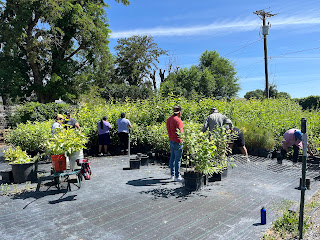POBR25 Day 12: Confederated Tribes of the Umatilla Indian Reservation (CTUIR), 6-26-25
Today was jam packed of education, work exposure, and fun.
First we started with the plant nursery and Gail Redberg who is the manager of
the facility, then we met with Andrew Wildbill at the CTUIR Agency to hear what
the program is about and a brief history lesson of the lands we are invited to
work on, then we capped it off helping Solai Le Fay who is a grad student out
of Boise State University studying Burrowed Owls and Lindsay Chiono, Habitat
Biologist, and finally Mr. Le Fay who was there learning with his daughter
Solai just like us rounding out this super interesting afternoon.
So, in the morning, we got to the plant nursery and Gail gave a briefing about how their mission revolved around using native plants to aid restoration efforts of streams and their pathways. They help a ton to keep the water cooler by their canopy and their use for bugs who lay their eggs on the plants which in turn help to sustain the fish diet. They will be getting into landscaping too which I find interesting because it poses questions you don’t think too much about like plant height and whether or not they will block the view of a window or interfere with an electric post. What I like the most about their work is the fact that they gather and cut their own plants alongside trading and selling to other tribes and communities. Overall, it was a good exposure to the operations of such a place.
Our second spot of the day has to do with a history of the
lands the Umatilla, Cayuse, and the Nez Perce were forced to share. Sacrificing
their way of life in cultures and tradition for the sake of colonization and the
settler's eagerness to move onto the lands. I learned a great deal in one short
lecture about the broken promises, the experimental programs the Oregon legislature
of the time enacted, and the very heartfelt teachings of unwritten laws the
Umatilla-Cayuse member Andrew Wildbill informed us about. I have a newfound level of respect for the lands now after learning
so much more about their resilience. Andrew was very informed about his work,
the tribe's culture, and the historical importance of their reservation. I am
happy to see they have such programs that allow for the land buyback programs
to do their work and regain their ceded lands. I appreciate that he sees the Yakama
Nation (my tribal affiliation) as ‘brothers and sisters’ since we share the
same ‘usual and accustomed’ area near Pahto (Mt. Adams) which upon hearing made
me happy to be part of the group this year and to hear the words he shared with
us. I would for sure return to help out on projects. I am a history buff by hobby
and that part was enriching for me since it is clear now that we share a very similar
history.
Finally, our group of environmental science and
environmental studies majors including Joellene, James, Raquel, and I had the pleasure
of working with Solai in our last stop for the day. We assisted in the
documentation of the Burrowed Owls in their habitat which are artificial
burrows meant to mimic the American Badgers who create the habitats for the
Burrowed Owls to live in. We learned a great deal about the owls from Solai, and
I am inspired to help in any capacity with establishing such a project back home
on the Yakama Nation Reservation. Before documenting the band, number Solai and
Priscilla did their work to pull the baby owls out of their safe spots which is underground and hidden away. As they
grabbed them, we immediately heard a very light rattle and clicking in their
defense.
As we got them up Solai and Priscilla tagged them, recorded
their information, and dusted them the ticks off them before letting us hold
them until we returned them to their holes to let them run back home. I have
worked with Spotted-Owl crew in the Yakama Fish & Wildlife but never
actually got to see them and this project in a single day allowed us to see and
hold 15 baby owls! I was stoked but they were not. We kind of stressed them out
but that was because we were handling them and when we put them down, I am sure
they got to relax awaiting their parents. The biggest number of babies in a burrow
today was seven so that was nice.
Huge thanks to the CUTIR for helping us and allowing us to participate
in these different projects, I am looking forward to (as usual) tomorrows
fisheries day. Although I am not a fisheries kind of guy it is cool to see the
differences in how tribes such as Wellpinit, Yakamas, and Umatilla's conduct
their research and stewardship.
 Photo of the crew working hard!
Photo of the crew working hard!
 The Cascara buckthorn tree gifted by Gail, very grateful. I'll try my best to get it to grow!
The Cascara buckthorn tree gifted by Gail, very grateful. I'll try my best to get it to grow!
 The first four baby owls we got to see, super cute owls smaller than the palm of our hands.
The first four baby owls we got to see, super cute owls smaller than the palm of our hands.


Comments
Post a Comment